Pilgrimage Through India & Nepal
1 Dec
I wrote this travelogue of my recent trip to Serpom and Nepal for http://www.tsemrinpoche.com/
Since my mother had passed away earlier this year, H.E. Tsem Rinpoche advised me to take my dad on a holiday. He suggested several countries like India, Nepal, Burma, Thailand and so forth.
Rinpoche said that we should go to these places to make our holiday a meaningful one because these countries are full of spiritual power places. In other words, we can go to these places to make good prayers, aspirations and offerings that would plant powerful seeds for his future life, especially for someone like my dad who is older. I could not do this for my mom since she had passed away, but I can definitely do this for my dad especially now that he is free and he is still healthy enough to travel.
After talking about it with my dad and my friend Paul, we decided that we should go to Nepal and we could bring Paul’s mom along. In fact, it would be my dad’s and Paul’s mom’s first time to Nepal and I can feel that it would be great. We felt that this was a good time to go and Rinpoche added that we should stop by a Tibetan monastery called Serpom in India to have our parents make offerings to the monks there. It would be great experience for them to collect merit. Therefore, the whole itinerary was revamped to include an extra destination and the visa application required to enter India.
Pilgrimages are basically a spiritual journey to power places in order to connect with the aspirations and energies of that place. These places are charged with the energy of enlightened beings that meditated, resided, consecrated or performed enlightened deeds in that location. Hence, we go to these places to connect with these energies in order to plant powerful blessings into our mind stream. The main places we would be going to in Nepal were power places of the tantric deity Vajrayogini and these are great places to connect with.
Pastor David Lai
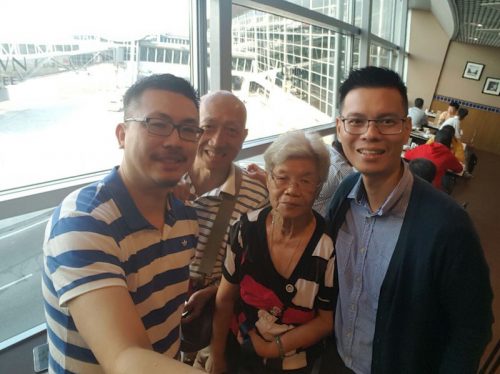
Serpom Monastery
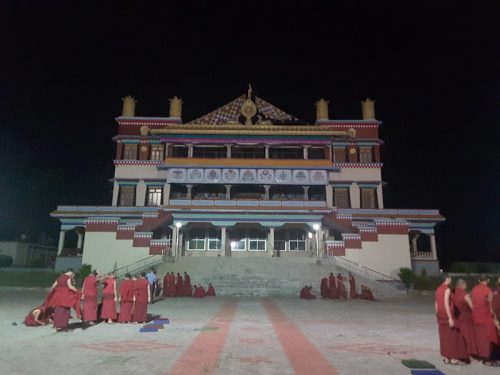
Monks engaged in debate at the courtyard of the main prayer hall at Serpom Monastery.
Serpom Monastery was originally Pomra Khangtsen, a part of Sera Mey Monastery. Due to the Dorje Shugden issue, the monks of Pomra Khangtsen were unable to remain in the monastery. Therefore, the entire Pomra Khangtsen had to separate and establish Serpom Monastery in 2008.
Some say that the very existence of Dorje Shugden monasteries like Serpom shows that Dorje Shugden practitioners have the freedom to practice and that the ban does not really exist. However, the reality of the situation is that the establishment of Serpom was forced upon the monks of this monastery, and that is why the very existence of Serpom Monastery is a living proof of the existence of the ban on Dorje Shugden.
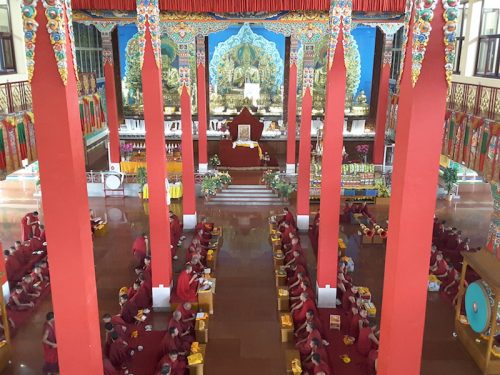
Bird’s eye view of the monks at the main prayer hall of Serpom Monastery while the monks were engaging in the Dorje Shugden puja.
Rinpoche suggested that we visit this monastery so that our parents get to make offerings to the monks personally in order to collect merit. In this manner, we lend our support to these courageous monks for our lineage. Coincidentally, Paul’s mother had set aside some money meant for a puja for her late husband, and my dad had also contributed an amount in dedication to my late mother.
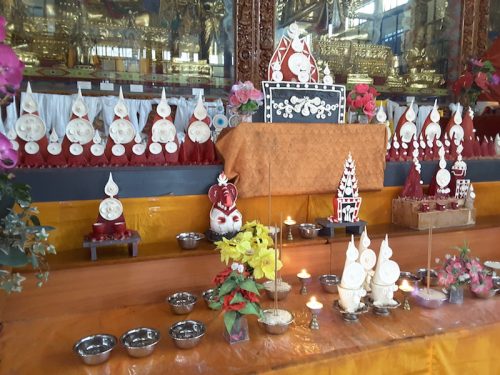
Beautiful tormas were offered to Yamantaka, Dorje Shugden Five Families and entourage.
Therefore, a large Dorje Shugden puja was commissioned and the torma ritual cakes, tsok food offerings, breakfast of bread and tea for all the monks are sponsored. In sponsoring the puja, Paul’s mother and my father also offered each monk Rs200 as a kuyong or monetary offering. The monastery has approximately 567 monks, and most of them attended the puja.
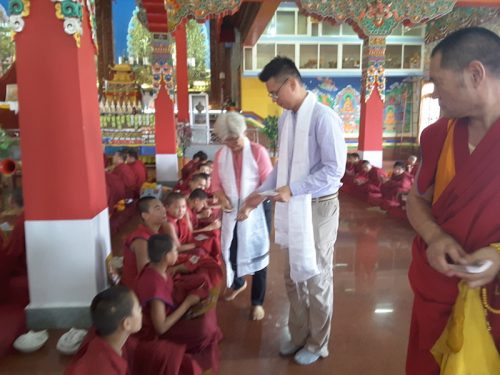
Paul assisted his mother while she made kuyong offerings to the each monk who was performing the Dorje Shugden puja.
We arrived in KempeGowda International Airport in Bangalore on the day before the puja. The monastery administrator had arranged for transport to the monastery so we can greet the monastery’s officials before they put us up at a nearby hotel for the night. We came back to the monastery the next day to make the offerings. But before that, we were taken on a tour of the school and library. Upon our return to the main prayer hall, the monks were on a break, and so we were ushered upstairs to have some tea. Not long after, the temple gong resounded, calling the monks to return to the prayer hall for puja.
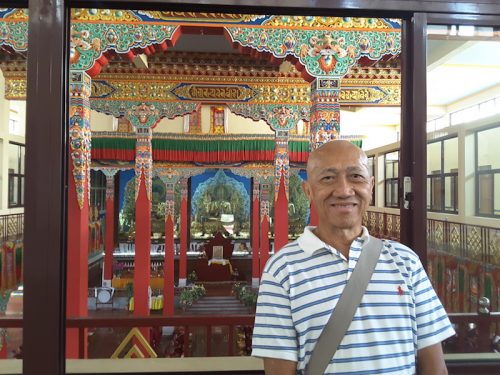
My dad, Uncle Lai, is excited to be here at the monastery for a chance to collect lots of merits by making offerings to the monks.
While the monks were in puja, we were ushered downstairs to the prayer hall. We offered three prostrations to the sangha, and we were given khatas to be offered onto the lama thrones, to every large statue and also to the protectors in the protector chapel. Then, we were ushered back upstairs, and at the right moment, we were ushered back to the prayer hall to make the kuyong offerings to the monks. The monks respectfully received the offering with their hands respectfully covered with their zen, which is the loose shawl-like part of their maroon robes. After completing the offering, we were ushered upstairs for lunch.
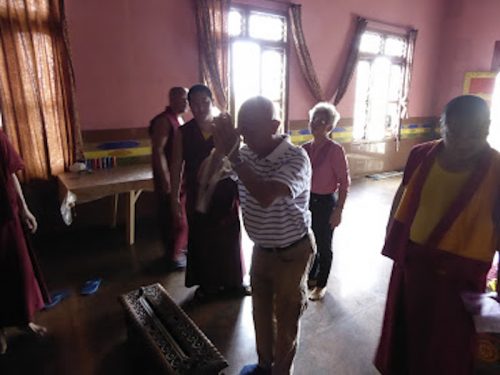
Uncle Lai and Paul’s mother made pearl offerings to Dorje Shugden at the Protector Chapel.
We returned to the protector chapel after the monks had vacated the temple for another break. We had requested to have the honour for our parents to offer pearl necklaces onto the statues of Dorje Shugden and his emanations at the protector chapel. This was Rinpoche’s idea and had pearl necklaces ready beforehand. So, I guided them with making the right motivation, which was to pray for their respective deceased spouse and family. For my father, I told him to pray to be free of obstacles to be able to do his Dharma work that had been assigned by Rinpoche so he can collect as much merits for his next life. We left the monastery not long after in order to head back to Bangalore to take the evening plane to Nepal.
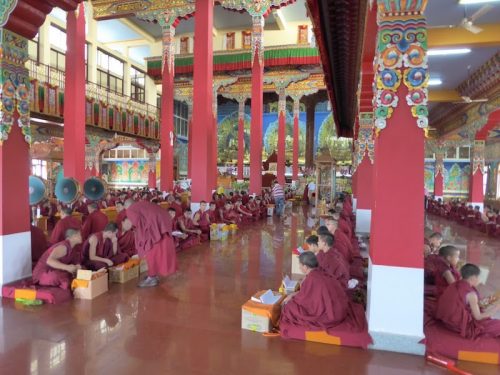
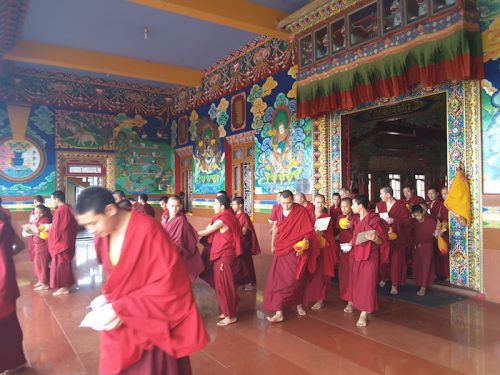
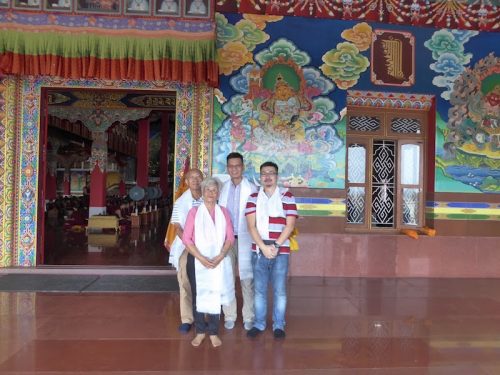
Seto Macchendranath
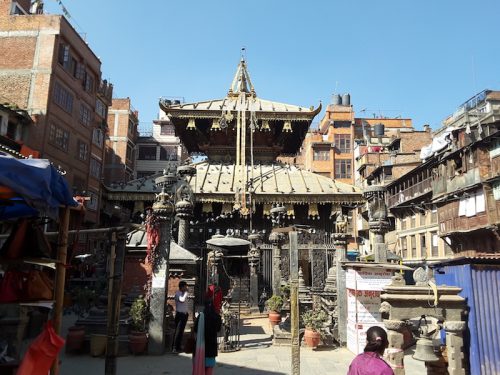
This is the ancient temple of Jan Bahal, where the sacred Chenrezig statue resides within.
We arrived in Nepal late in the evening, and we decided to have dinner at our hotel and planned our destination for the next few days. The next day, we decided that it would be good to visit all the nearby destinations, and the first on the list was the nearby Chenrezig and Tara temples.
We took a taxi that brought us close to the temple, but the taxi driver was unsure of the temple’s location. We arrived at Assan Tole, it was an ancient narrow street bazaar, chock-full of Nepalese street vendors hawking flower garlands, vegetables, clay pots and so forth. The street was just crowded with shoppers and passerbys crisscrossing in all directions. We navigated through the crowd, asking for the temple’s direction. Fortunately, Jan Bahal, the home of the Chenrezig statue was easily found.
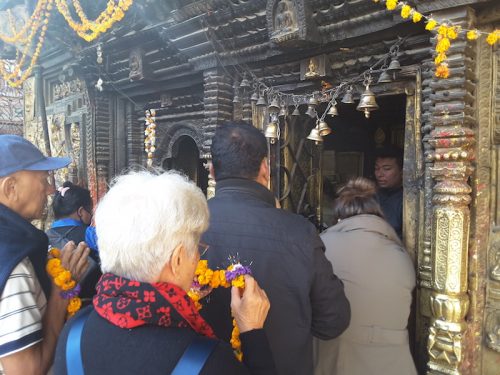
We offered garlands and butterlamps along with our mantras and prayers to Chenrezig.
The Nepalese call this deity; Seto or White Macchendranath and both Hindus and Buddhists worship this deity. To the Hindus, he is the avatar of Shiva that brings rain and bountiful harvest. For the Buddhists, he is Arya Avalokiteshvara, the bodhisattva of compassion. The Tibetans calls this sacred image Jowo Dzamling Karmo, and he is one of the Four Exalted Brothers. According to legend, this image along with the other three arose from a single Sandalwood tree. One of the images is in Patan and whose face is painted red, and he is known today as Rato or Red Macchendranath. Another one by the name of Phagpa Wati of Kyirong is in the possession of His Holiness the Dalai Lama, and the last one is known as Lhasa Lokeshvara that is part of the Potala collection.
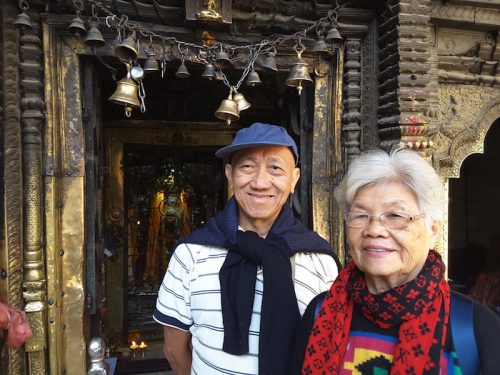
Hence, this Chenrezig statue is really old and the courtyard itself has several old Tara statues enthroned on pillars and the walls of entire temple is covered various forms of Chenrezig. There are even prayer wheels along the way around the temple allowing pilgrims to turn them as they make their devotional rounds. We offered butterlamps, prayers, mantras and even circumambulated Chenrezig by going around the temple.
One of the female temple caretakers looked a little crazy, and I whispered to Paul that at holy places like these, Rinpoche said we should always make offerings to crazy-looking female beggars and not ignore or chase them away because they might be emanations of dakinis. Paul immediately took out a little bit of money and offered it to her. I did the same when I crossed her path later, and she smiled broadly back at me. Before we left the temple; we held hands, closed our eyes and dedicated.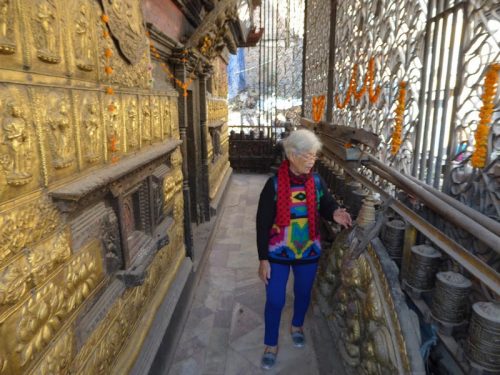
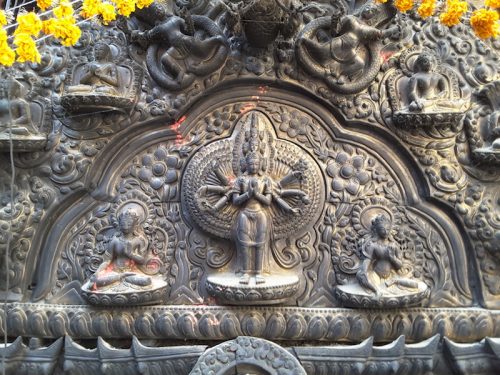
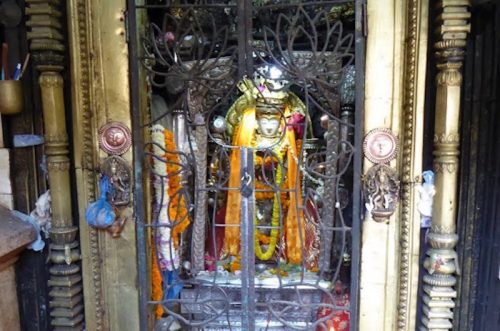
The sacred face of Chenrezig Jowo Dzamling Karmo
Itum Bahal Tara
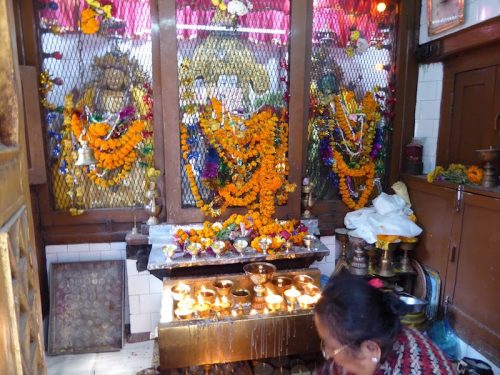
This sacred White Tara statue that flew miraculously from Tibet is in the middle and flanked by Yellow and Green Tara.
Our next destination was the Tara chapel of Itum Bahal. Itum Bahal is an ancient 14th century Buddhist monastery and it was not easy to find as we had to ask quite a number of people before arriving at the main temple courtyard. A nondescript chapel to a trinity of Tara statues sits in a smaller courtyard off from the main larger temple courtyard. The central statue is an old statue of White Tara that according to Kyabje Trijang Rinpoche is a Tara statue that flew miraculously from Tibet.
It flew to Nepal to be of benefit to the beings here, and it is also a statue that spoke to great masters who paid homage to her. We offered butterlamps, flower garlands, Tara mantras and circumambulations. However, I advised our parents to pray for long healthy lives in order to engage in spiritual practises. The chapel was really small but popular as we can see that other Tibetan pilgrims are streaming into the courtyard. After dedicating, we left the temple grounds and got back to the main street in order to go back to the hotel for a break.
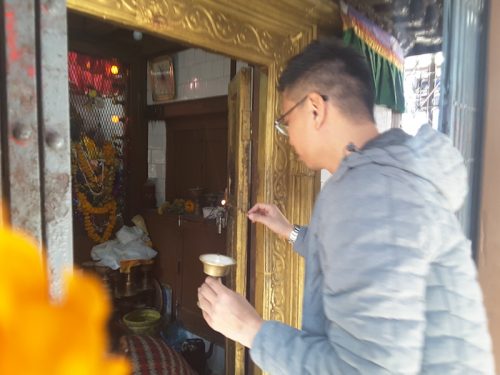
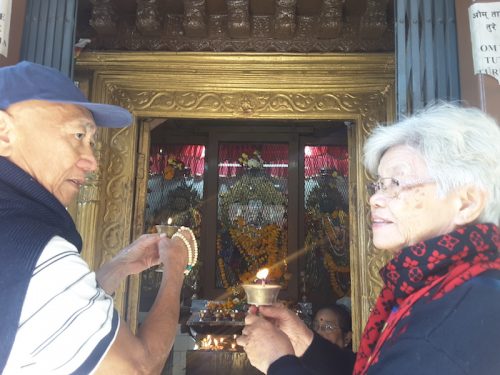
Bidjeswori Vajrayogini
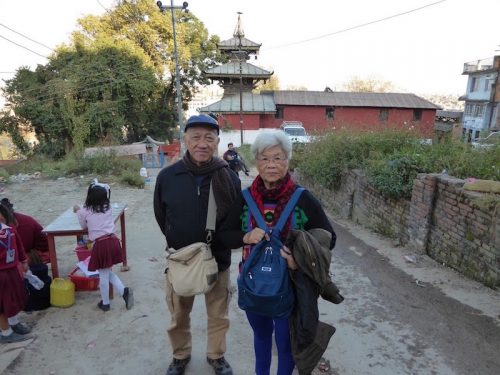
This was taken just outside of the Bidjeswori Vajrayogini temple and the pagoda roof you see is directly above the Vajrayogini shrine.
Our next destination is the Bidjeswori Vajrayogini Temple, and it is also known by a few other names, Bijayaswar or Visyasvari Temple. This is an ancient Newar Buddhist temple dedicated to the Tantric Buddha Vajrayogini or Bajra Jogini in the Newar language. The Newar people are a mixture of Indo-Aryan and Tibetan-Burmese ethnicities and they form the original inhabitants of the Kathmandu Valley. They are the creators of its historic heritage and civilisation in Nepal.
Before heading out to the temple, I went to buy some offerings for Vajrayogini so as to create a powerful connection with her. The temple stands on the west bank of the Bishnumati River not far from Thamel, and it is also believed to be next to the ancient charnel grounds of Ramadoli (Karnadip). The temple sits within a courtyard of stupas and the inner sanctum is a shrine to four sacred Vajrayogini statues. The central image is that of Akash Yogini or the sky-going Vajrayogini. To her left is Phamthing Vajrayogini with her left leg thrust skyward and her right is the celestial dancer Vajravarahi. Then there is a statue placed on the right wall is a statue of the haunting Naropa’s Dakini.
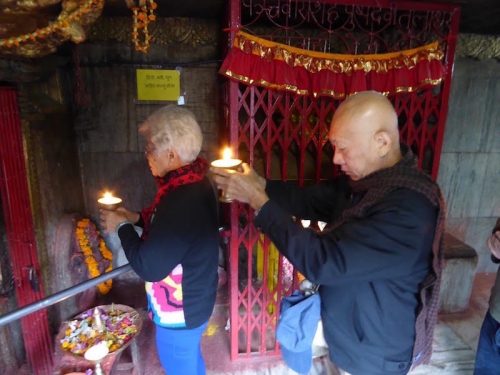
I unpacked the food offerings onto little plates to be offered and the temple caretaker helped to place it near Vajrayogini as we did our prayers. We made butterlamp offerings and in this temple, I told our parents to pray to have the merits to be reborn under similar circumstances to be near a teacher of authentic lineage of Vajrayogini and to receive her practice again. As we were making these aspirations and offerings, the temple caretaker screamed at Paul for taking pictures so close to the shrine and would not allow him inside. Nepalese are highly sensitive about people taking pictures of their sacred shrines.
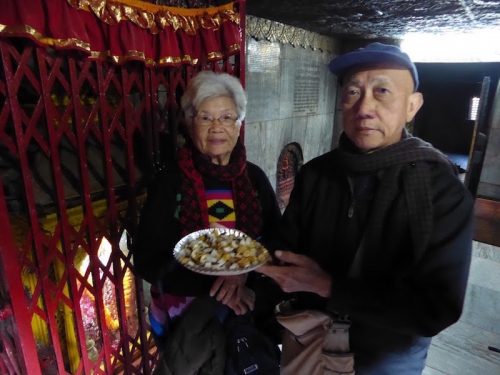
Just before exiting the temple, I offered one of my late mother’s jewelled earrings, and I asked the temple caretaker to help me place it on Vajrayogini herself in order to collect merit for her. I gestured for him to place the earring on Naropa’s Dakini. I prayed that she would be blessed to be connected to the Dharma in her next life and be connected to the Dharma and Vajrayogini.
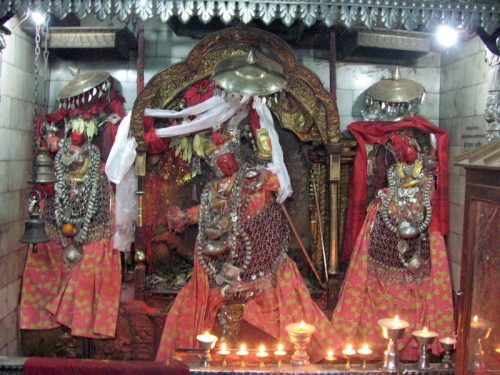
The main image of Vajrayogini is Akash Yogini or the flying Vajrayogini and on her left is Phamthing Vajrayogini and on her right is Vajravarahi.
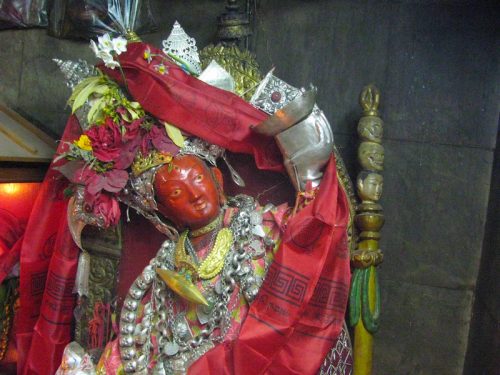
Naropa’s Dakini is enshrined on the right wall, and it is to this statue that I offered my late mother’s earring.
Sankhu Vajrayogini
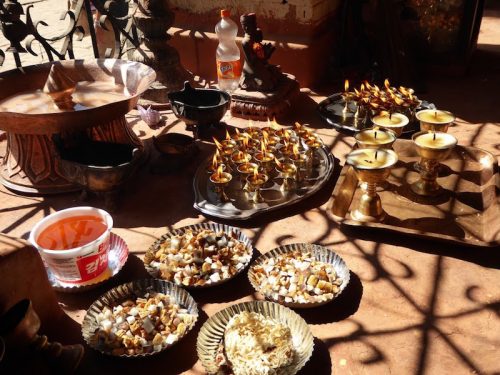
We made abundant offerings to the Sankhu Vajrayogini.
We hired an SUV to take us up into the hills and into Sankhu because that would be the farthest destination. It is only about 17 kilometres but because the recent earthquake had destroyed the road, the journey felt much longer than 17 kilometers. At Sankhu, we were headed towards Gum Bahal, which is an ancient monastery situated on top of a hill that is power place of Vajrayogini.
On a previous trip with Rinpoche, we had arrived at the bottom of a stairs late in the evening, and we had to climb a flight of stairs in pitch-black darkness with torches in order to get to the monastery. This time around, the driver drove us right up the hill and the road ended right behind the monastery. The monastery itself is a custodian of a special 4-armed Vajrayogini bearing a sword, lotus, skullcup and ritual chopper. This form of Vajrayogini is known as the Khadga Yogini or the sword-bearing Vajrayogini.
The statue in the monastery itself is a life-sized Khadga Yogini that is believed to contain the remains of a priestess of Sankhu that was a great practitioner of Vajrayogini. She was said to have become one with Vajrayogini, and she showed many signs of high attainments. Even at death, her remains bore remarkable signs and hence, they enshrined her within this statue. The local people bring this statue out yearly to parade her around town in a weeklong religious festival called the Vajrayogini Jatra.
Due to the earthquake, the monastery was under repairs, and the statue was brought to a room facing the courtyard while the monastery was being restored. I unpacked offerings of food and apple juice. We offered butterlamps, prayers, mantras and especially an aspiration that I had guided them to make. I told them that in this second Vajrayogini temple, we should pray in future lives that we will always meet Vajrayogini and receive her practice from a teacher of authentic lineage. Then, we will gain great attainments through our Vajrayogini practice and enact the altruistic deeds of a Bodhisattva by benefitting many beings.
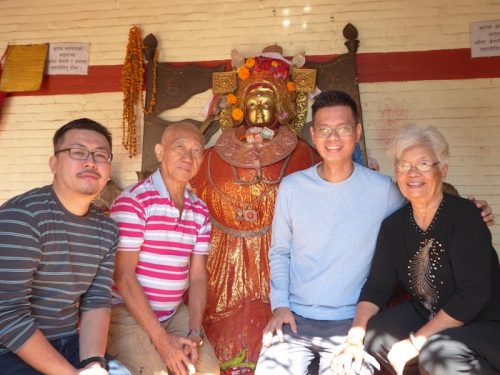
A picture with the Sankhu Vajrayogini statue believed to contain the remains of the great yogini who had become one with Vajrayogini.
We made a dedication and took a walk around the courtyard of the monastery and down a small flight of stone stairs towards a twin pagoda shrines. At the large of the two shrines, we discovered another very ancient statue of Khadga Yogini is enshrined within and a stupa is enshrined in the other smaller shrine. So, we paid homage to both shrines by offering butterlamps and reciting mantras at these two ancient shrines. I recall that there were some caves nearby that were used by Tilopa, Naropa and the Nepalese Pamthingpa brothers. Unfortunately, we couldn’t visit these caves due to ongoing restoration works.
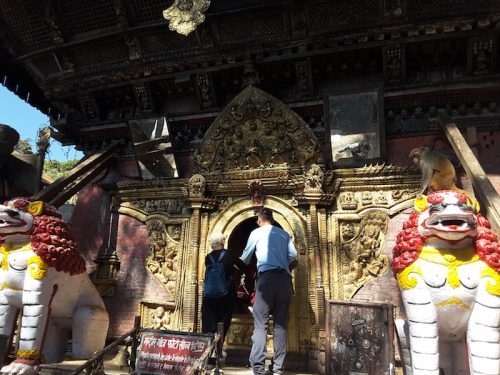
Paul and his mom were making offerings before the shrine to Vajrayogini in the aspect of Khadga Yogini.
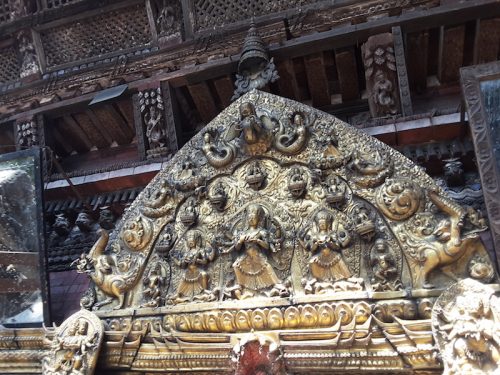
Boudhanath Stupa
After Sankhu, we drove back to Kathmandu and went on towards Boudhanath. The Boudhanath stupa is reputed to be the largest stupa in the world. Traditional sources say that the great Boudhanath Stupa was constructed in the 5th Century CE. The stupa is believed to enshrine the relics of the previous Buddha, Kashyapa Buddha.
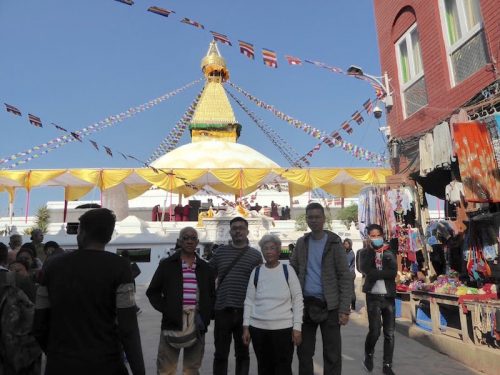
We arrived at the Boudha Stupa when they were about to re-consecrate the stupa after restoration works. The stupa was damaged during the recent earthquake.
According to legend, a long time ago Jadzimo and her four sons built Boudhanath, which is known as Chorten Jarung Khashor with money that they saved from their wages. When the stupa was consecrated, it was believed that 100 million Buddhas dissolved into it, and it has the glory of being filled with sacred relics. It is believed that the stupa was built on top of the cremation ground called ‘Spontaneously Amassed’, which was one of the Eight Great Cremation Grounds.
The name Jarung Khashor refers to another legend of its origin in which a courtesan who wounded the pride of the wealthy and powerful by managing to construct this stupa to the Buddha with the permission of the king. The jealous nobles requested the king to demolish the Stupa over petty reasons, but the king replied that “Once authority to build has been given, it cannot be retracted”, which is reflected in its name, ‘Jarung Khashor’.
Guru Rinpoche while in Samye monastery told another tale of the Boudhanath Stupa. He explained that the aspirational prayers of the benefactor Jadzima’s sons, created the cause for them to be reborn as the principle force behind the spread of the teachings in Tibet – Guru Padmasambhava, the King Trisong Detsen, Santaraksita and Ba Salnang. When they met in Nepal and Tibet for the very first time, it felt like a reunion. Guru Padmasambhava foretold that the Stupa would fall into ruin and a certain tulku with a certain special characteristic would restore the stupa. It turns out that Sakya Zangpo discovered the ruined Stupa in the 16th century and undertook the task to restore it to its former glory. In 1505, he also contributed towards the restoration of Swayambhunath.
Today, the Boudhanath Stupa is a World Heritage Site and Buddhists and tourists from around the world come to visit this ancient monument. Most people who come to visit, would be circumambulating the stupa, and some would be within the walled enclosure of the stupa and performing prostrations towards the stupa. The stupa itself is surrounded by shops filled with jewellery, statues, thangkas and not to mention the cafes, restaurants and monasteries and temples of various Tibetan Buddhist traditions. We came here to look for a place to eat before we did our devotional rounds around the stupa. After circumambulating with the growing crowd as more and more older Tibetan pilgrims came out to circumambulate the stupa in the evening. After our third round, we called it a day and returned back to our hotel.
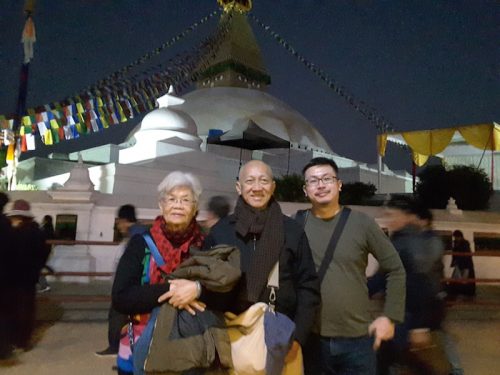
Pharping Vajrayogini
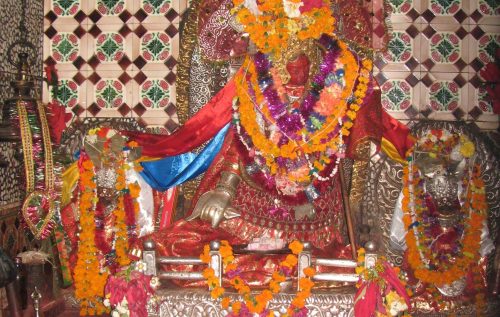
This unique Vajrayogini with her left leg thrust skywards is from a pure vision by the Nepalese master Phamthingpa.
Pharping is a good 19km south of Kathmandu city and is a major Buddhist site due to a number of sacred sites. There are three places that are in the vicinity of each other and the ancient Vajrayogini chapel is one of the main reasons we are headed to this place. On my previous trips, we stopped by the Self-arising Tara temple first and then we walk up the stairs to Asura caves and finally descending down another flight of stairs to the Vajrayogini temple.
This time around, the car we rented brought us straight to the Vajrayogini temple. So we approach the temple and walked upstairs to the Vajrayogini shrine, and I could see that the caretaker really cleaned up the place. It was a lot cleaner than the last few times I came. The inner sanctum sits an ancient statue of Vajrayogini with her left foot thrust skywards. This form of Vajrayogini is known as Phamthing Vajrayogini, Uddhapada Yogini or Indra Yogini. Apparently, this form of Vajrayogini appeared to the master Phamthingpa in a vision, and although it is unclear if this statue belong to Phamthingpa or not but this statue is known to have miraculously spoken.
The 11th century Nepalese master Phamthingpa was one of the greatest teachers of his day and was also known as the great scholar Vagishvarakirti. He studied under Naropa for nine years, receiving the transmission of the Cakrasamvara and Hevajra Tantras amongst others. Even his brother, Dukhorba studied under Naropa for five years and his youngest brother Thangchungpa was a practicing Tantrika as well.
Naturally, we brought lots of offerings to be offered to Vajrayogini, which we offered via the caretaker along with mantras, prayers and aspiration. It is at this place that I guided our parents to make the aspiration that upon receiving Vajrayogini in our next life; we master it and become completely enlightened with Vajrayogini’s meditations and practises. It is to master her meditations and practices and thereby proliferate it to others. After everything was done, I took out the other jewelled earring from my late mom and gave it to the caretaker to be placed onto the statue of Vajrayogini. I prayed that my mom would be blessed by Vajrayogini to have the merits to meet the Dharma again and specifically meet Vajrayogini in her next life.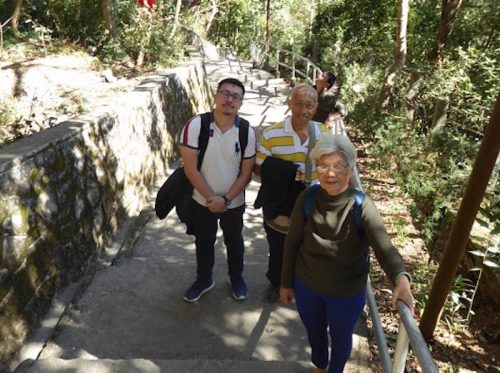
Asura Cave
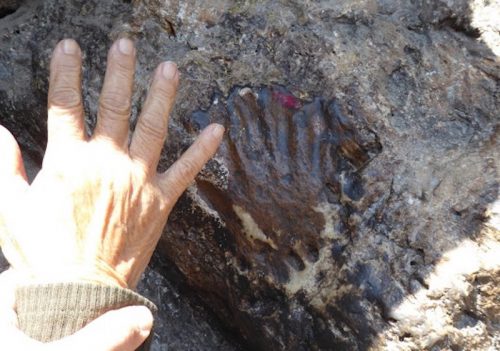
The sacred handprint of Guru Rinpoche is just next to the mouth of his retreat cave.
Our next destination was a Nyingma monastery built around a single cave called the Asura Cave. This monastery is approachable only on foot by climbing up the hill from the Vajrayogini temple. After a short flight of steep steps, we arrived at the back of the monastery.
When we arrived, the nearby prayer halls were packed and it seemed that Chokyi Nyima Rinpoche was giving teachings. Nonetheless, we managed to enter the cave to offer our prayers, mantras and aspirations. There is a darkened image of Guru Rinpoche, Yangdak Heruka and Vajrakilaya on a shrine with the cave. There is a handprint of Guru Rinpoche by the side of the mouth of the cave, sealing his blessings there. It is believed that Guru Rinpoche achieved high realisations through his practice here and he was able to imprint his hand into solid rock.
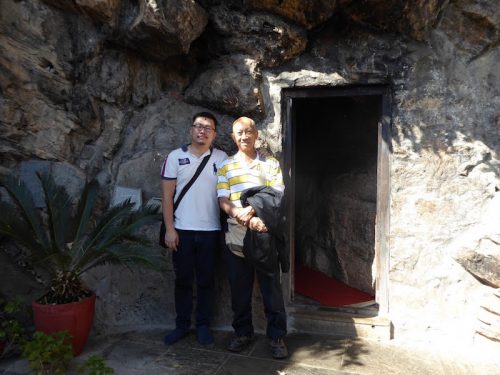
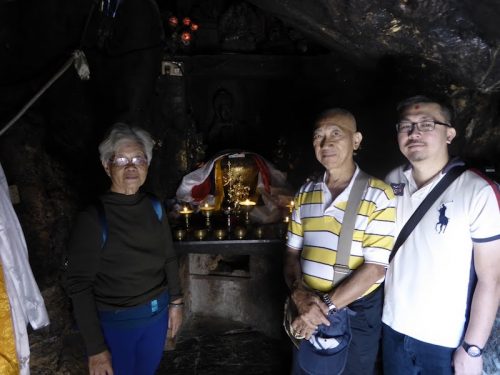
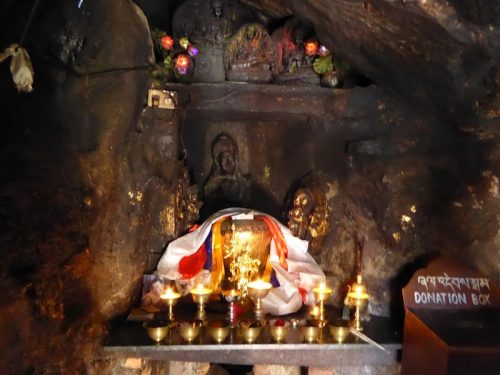
In Guru Rinpoche’s cave, is a shrine to darkened images of Guru Padmasambhava, Yangdak Heruka, and Vajrakilaya
Self-arising Tara
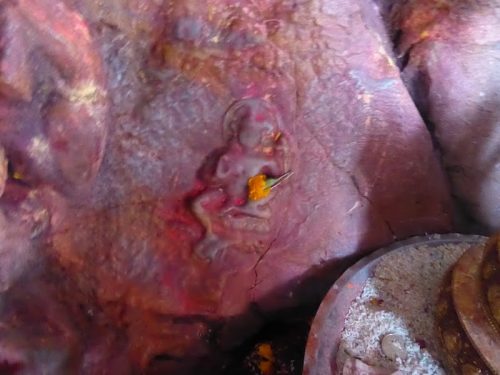
This self-arising Tara image seems to get clearer each time I visit this chapel.
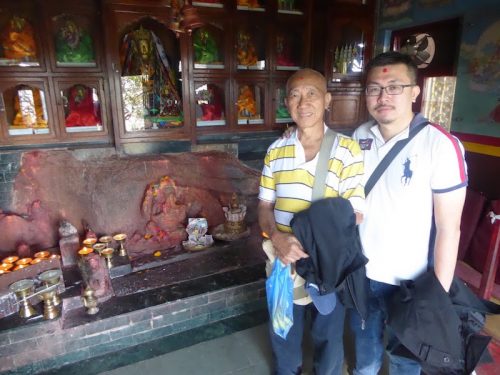
In order to get to the next destination, which is the Tara temple, we walked to the front of the monastery where there was another flight of steps downhill. Descending down the steps, we came across a Nyingma prayer hall to the left and a small little Tara chapel on the right and a chapel to the Tselha Namsum or the three buddhas that grand long life – Amitayus, White Tara and Namgyalma.
The Tara chapel is a shrine to a rock and from within the rock, a large image of Ganesh had arisen from the rock. Upon first sight, we couldn’t see Tara but on closer inspection, we saw a small but distinct image of Tara rising from the side of Ganesh. These images were not carved but have arisen from within the rock itself. It is said that great meditators and holy beings blessed the place and hence, Tara had chosen to manifest here. There was a single monk there when we visited and he was doing his Tara recitations. Naturally, we made some offerings to him, offered butterlamps, Tara mantras and rubbed our malas on Tara’s feet, hopefully to glean some blessings into our malas. We didn’t stay very long as a whole group of Tibetan pilgrims came shuffling in and crowding the place up.
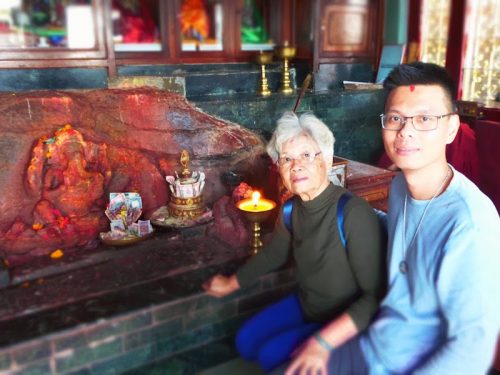
Patan Vajrayogini
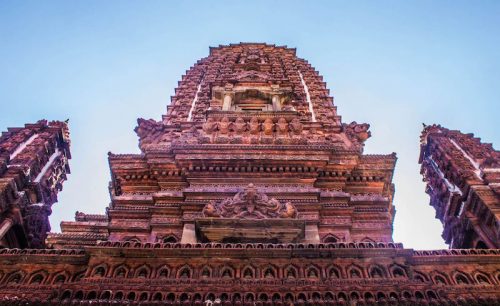
The Mahabouddha Stupa is a scaled down replica of the great Mahabodhi Stupa at Bodhgaya, India.
The next day, we took a ride to Patan which also known as Lalitpur, an ancient city known for its beauty. We were headed to the Mahabouddha, a scaled-down replica of the Mahabodhi stupa at Bodhgaya India. This is situated in the old part of town, not far from the Patan Durbar Square. The stupa is not visible from the road and you have to walk a narrow alleyway between shops till you arrive at a little entrance to the courtyard.
The Mahaboudha stupa is built in the middle of a courtyard which enshrines a statue of the Buddha in it and apparently, the statue was brought back from Bodhgaya itself. The stupa was originally built in the 17th century by the artisans of the city for those who could not travel down to India for pilgrimage. This is a beautiful shrine to the Buddha but this is not exactly our main destination. We were here because there is a Vajrayogini chapel just opposite from the Mahaboudha stupa.
The chapel is accessible through a flight of steps that overlooks the stupa. The main image of the shrine is the flying Vajrayogini statue. We did the same here in this chapel by offering food, butterlamps, mantras and aspiration. This was the last Vajrayogini temple on this pilgrimage and I told our parents to pray to be completely enlightened with Vajrayogini’s practice and to ascend to Kechara Paradise while bringing many beings along. That should be our aspiration just in the same manner of how great mahasiddha who liberated many after they themselves gained great attainments.
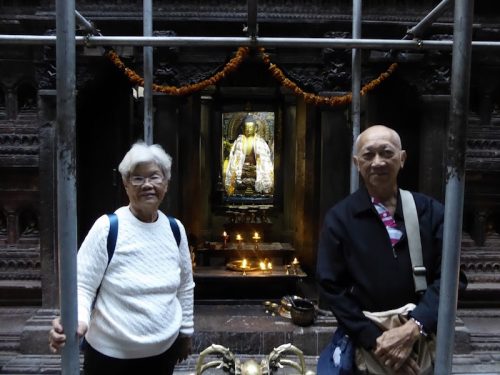
This is the Buddha statue that originated from Bodhgaya, India.
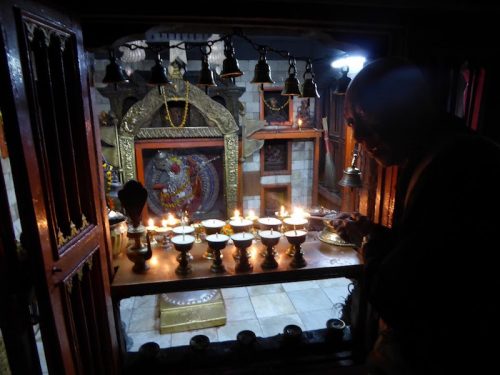
Offering beautiful butterlamps to the sacred image of the Akash Yogini or flying Vajrayogini.
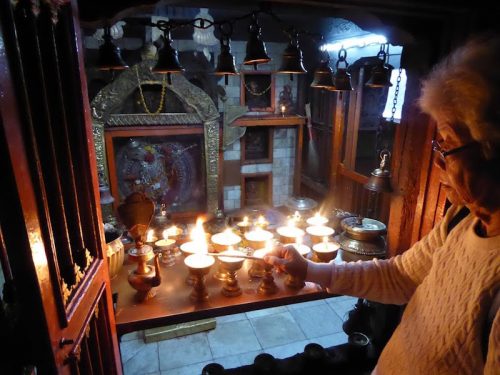
Swayambhunath Stupa
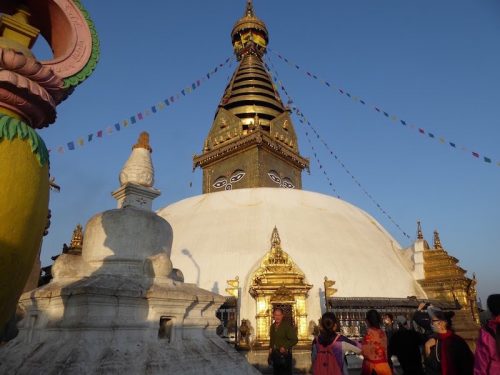
This is known as the monkey temple due to sheer amount of monkeys living on the hill. This is the second largest stupa in Nepal and perhaps one of the most iconic because it is situated on top of a hill. Unfortunately, the earthquake devastated the temple and destroyed quite a number of its structures and temples surrounding the stupa. The stupa itself had survived the earthquake unscathed.
There were three places we had to go and the first one is Manjushri’s site. This is on one side of the hill that is just a platform with prayer flags and some prayer wheels. This place is believed to be where Manjushri would appear to teach the local gods and celestial beings above the ground. We are unable to see this but those with psychic abilities or attained are able to perceive this. For the Nepalese, this is the site from which Manjushri stood and wielded his great flaming sword to carve out Kathmandu Valley in ancient times in order to drain a great lake. Needless to say, we offered several butterlamps and recited Manjushri’s praise and mantras in order to tap in his wisdom here.
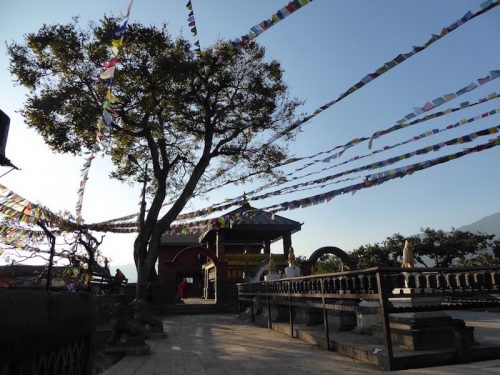
The convergence of prayer flags and prayer wheels is the only thing that identify the location of the site where Manjushri is said to teach the local deities.
The next destination was the Swayambhunath stupa itself and we circumambulated the stupa 3 times, while rolling the prayer wheels, and peering into the niches that contained shrines to the Dhyani Buddhas and their consorts. After that, we walked past a group of smaller stupas and stroll down towards an old building. Unfortunately, the earthquake damaged the building so badly that scaffolding was erected to support the structure and prevent it from collapsing. This is the temple of the doors, which is believed to be the doors to the underground system of caverns – the main doorway into the abode of the 16 Arhats known to bestow long life. Hence, we did some prayers and aspirations for long life, especially for our parents. After that, we left Swayambhunath hill.
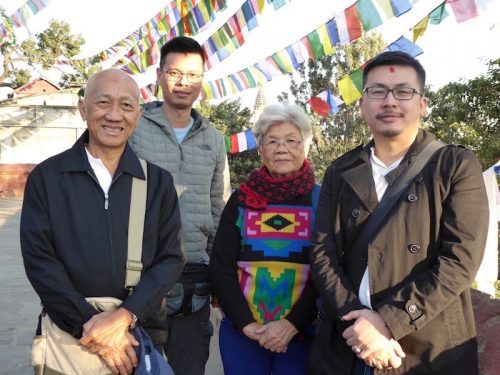
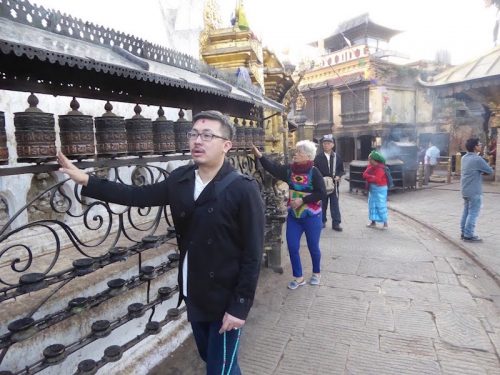
In order to tap into the blessings of the Swayambhunath Stupa, we circumambulated the stupa clockwise while reciting mantras.
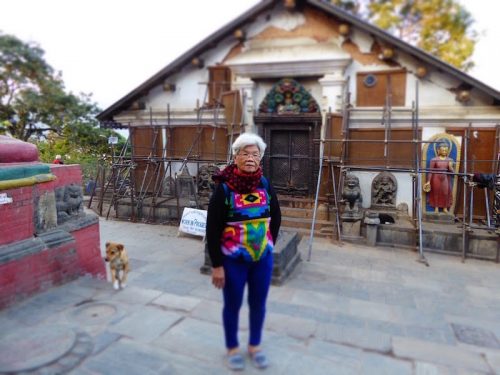
Paul’s mother stands in front of the temple of the doors. It was damaged by the recent earthquake and the entire building is held up by metal scaffolding.
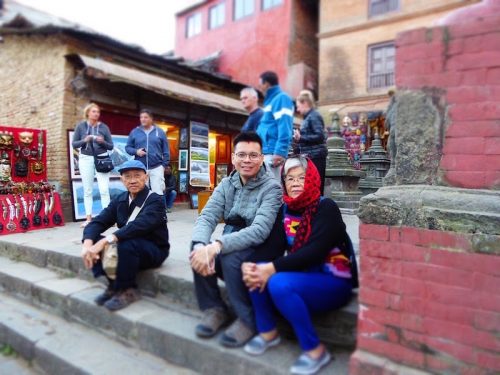
Naropa’s and Tilopa’s Caves
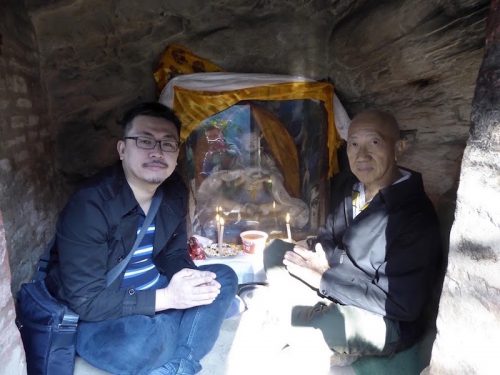
Taking a sacred picture with Naropa along with a feast of offerings that we have prepared for him.
On the last day, we paid a visit to Naropa’s and Tilopa’s cave near Pashupatinath temple complex. The temple complex is one of the largest Hindu temples in Nepal and one of the most important in the Hindu world. It was built along the Bagmati river and had ancient platform-ghats along the river where the deceased are cremated in plain sight of all who walk pass.
We could see that a Hindu Brahmin priest was preparing an old lady for cremation. Just witnessing the cremation was a contemplation of death and impermanence. We walked across a bridge towards the temple and along the ghats towards the far end of the river where there were some dwellings and caves by the side of the river. Sadhus probably lived in these dwellings for centuries and two particular caves were traditionally attributed to the Buddhist yogins, Tilopa and Naropa.
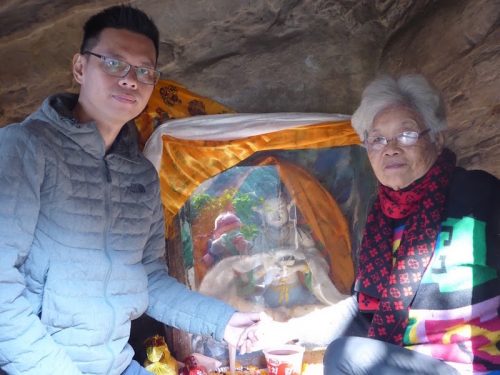
Their caves were cemented over and images of both masters were placed in them to commemorate the spot in which they had meditated. Naropa most likely meditated and received visions of Vajrayogini here in this very cave. This was also where he lived and served his guru by begging for alms and washing his clothes by the river below. A story of Naropa’s diligence and devotion to his teacher was appropriately told as it was the perfect story and example of devotion to a teacher. Hence, our aspirational prayer was to develop such devotion towards an authentic teacher so spiritual attainments could easily come.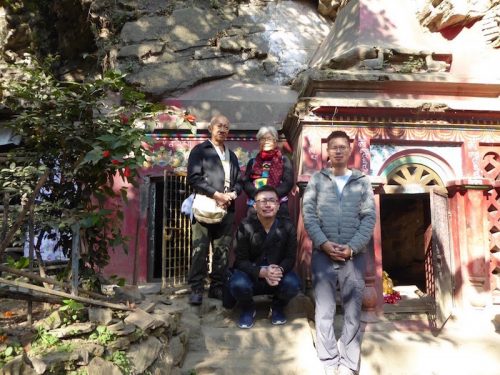
Conclusion
The pilgrimage was one that connects the four main Vajrayogini temples along with other power places and the offerings and aspiration generated at these places are very powerful. Hence, at each temple the aspiration is a unique one and it is about praying to meet a guru with authentic lineage, receiving Vajrayogini’s practice, becoming attained through her practice, benefitting many beings through her practice and finally ascending to Kechara Paradise and bringing many beings along to Kechara Paradise. It is hoped that these would plant powerful spiritual seeds for my father and for Paul’s mother as well. Since, they are older and hence closer to death, this would be good preparation for the eventual step that all of us have to take.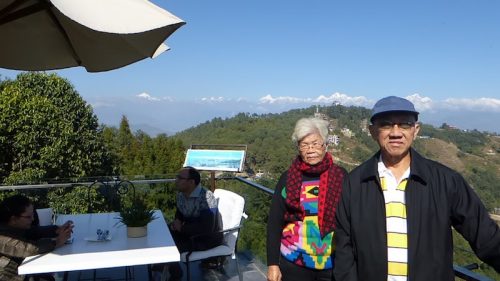





Thank you Pastor David for sharing your visits to Nepal and India. I really like the idea of Guru Rinpoche had suggested to you for pilgrimage to these beautiful sacred places and monasteries with your dad.The scenery are beautiful and I hope that one day I will have a chance for a visit.